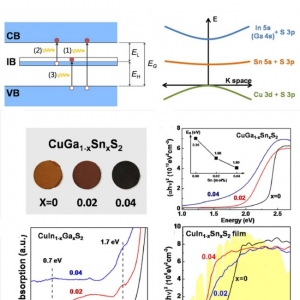The prospect of solar cells addressing energy and environmental issues by replacing existing fossil fuels is increasingly recognized and promoted by the world. However, the photoelectric conversion efficiency of solar cells is still not high at present. There are three main factors affecting the photoelectric conversion efficiency: one is the absorption of light; the other is the separation and transmission of photogenerated electron hole pairs; the third is the collection of charge.
Photovoltaic materials are a key part of solar cells. Therefore, the main way to improve the photoelectric conversion efficiency of solar cells is to increase the absorption of light by photovoltaic materials and to suppress the recombination of photogenerated carriers. The research on both of these focuses on energy bands. Regulation. How to prepare a new type of photovoltaic material with position matching is still a difficult and hot topic in current research.
Recently, the research group of photoelectric conversion materials and devices led by Huang Fuqiang, a researcher at the Shanghai Institute of Ceramics, Chinese Academy of Sciences, and the Department of Chemistry of Peking University have conducted a reasonable incorporation of Sn in In/Ga sites for chalcopyrite structural battery materials CuInS2 and CuGaS2. Miscellaneous, successful introduction of a half-filled intermediate band in the middle of the forbidden band (Sn-doped CuGaS2 has a band gap reduced to 1.8 eV, while the absorption range extends to 1.0 eV in the near-infrared region, and Sn-doped CuInS2 thin film reduces the band gap As little as 1.0 eV) as a springboard for low-energy photon transitions, overcomes the limitation of the material's optical band gap on the spectral response range of the sun, and realizes three photon-excited electron transition channels for VBM CBM, VBM IB, and IB CBM. Covering most of the solar spectrum's response greatly increases photocurrent, which is expected to dramatically increase battery conversion efficiency.

Energy Band Schection and Broad Spectral Absorption Spectra of Sn-doped CuGaS2 Nanoparticles and Sn-doped CuInS2 Thin Films

KBiFe2O5 crystal structure, polarization temperature response and room temperature magnetic response, spectral absorption and photoelectric response diagram
The cooperation team achieved a reduction in the forbidden band width of the material based on the regulation of the ion coordination field in the center, and explored a novel narrow band gap ferroelectric photovoltaic material: KBiFe2O5. Compared with the octahedral field, the tetrahedron field has a smaller splitting energy, which can effectively reduce the bandgap of the material. The sample structure is a three-dimensional framework structure with tetrahedral coordination FeO4 tetrahedral layers connected by Bi2O2 chains. The band gap is 1.59 eV, which is the narrowest forbidden band width in the known high temperature multiferroic materials. Due to the presence of the intrinsic polarization field, the recombination rate of photogenerated carriers is effectively reduced, and the sample exhibits a clear photovoltaic response, resulting in a photo-generated voltage that breaks through the bandgap of the material, with a voltage as high as 8.8 V and photocurrent of 15 mA/cm2. Above the best known ferroelectric photovoltaic material properties.
The significance of this research result lies in the fact that on the one hand, a new type of intermediate-band solar cell material has been successfully prepared and a broad spectral response and photocurrent have been greatly improved; on the other hand, the structurally controlled bandgap width in ferroelectric photovoltaic materials has been realized. The idea has provided new ideas for the development of a new generation of new solar cells with controlled microstructures and high photoelectric conversion efficiency.
The study was funded and supported by the National Natural Science Foundation of China, the National 863 Program, the Innovation Project of the Chinese Academy of Sciences, and the Class B pilot project of the Chinese Academy of Sciences. The relevant research results were published in the journal Nature Scientific Research (2013, 3, 1265; 2013, 3, 1286).
Actuator make a valve enter into a new era of application, Valve Actuator, Evolved Torque Works For Flow Control Automation! Supply Series of Actuators such as Electric Actuator, Linear Valve Actuator, Rotary Valve Actuator,Motorized Valve Actuator, etc. are for Flow Control Automation
Electric Actuator, Linear Valve Actuator, Rotary Valve Actuator,Motorized Valve Actuator, Flow Control Automation
Zhejiang Philic Fluid Control Co.,LTD , https://www.philicflow.com
